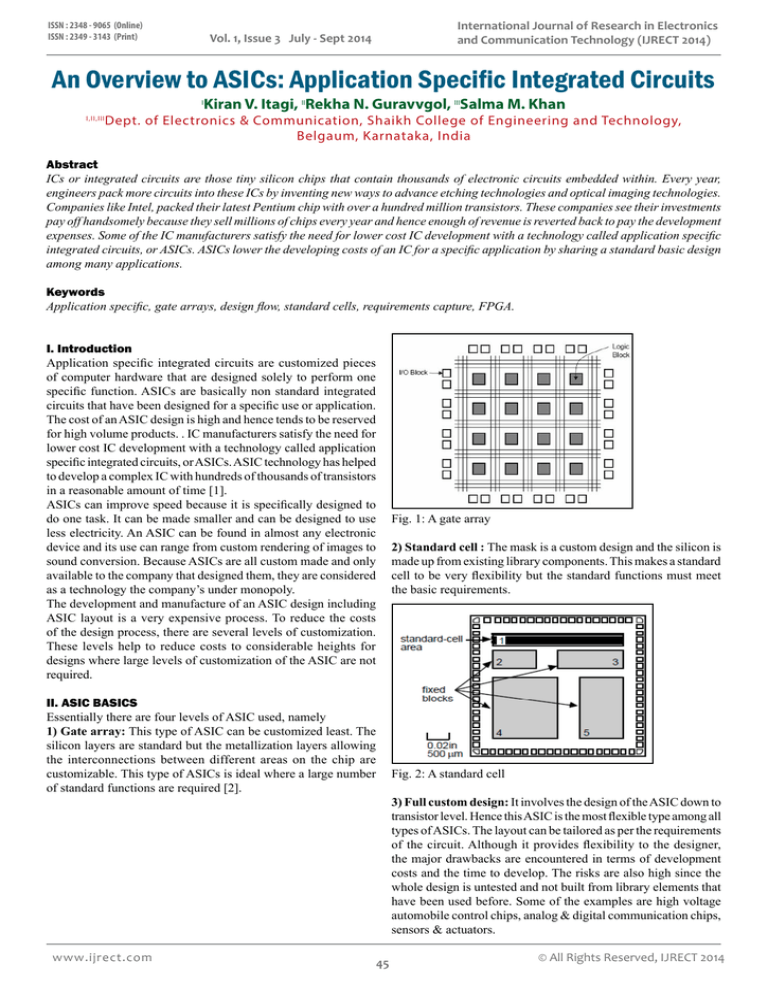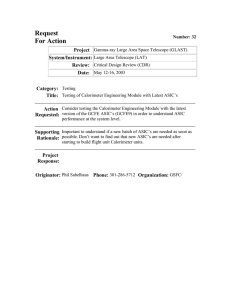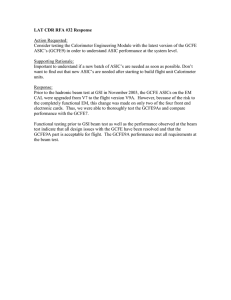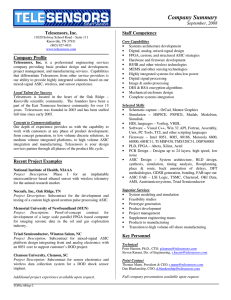
ISSN : 2348 - 9065 (Online)
ISSN : 2349 - 3143 (Print)
International Journal of Research in Electronics
and Communication Technology (IJRECT 2014)
Vol. 1, Issue 3 July - Sept 2014
An Overview to ASICs: Application Specific Integrated Circuits
Kiran V. Itagi, IIRekha N. Guravvgol, IIISalma M. Khan
I
I,II,III
Dept. of Electronics & Communication, Shaikh College of Engineering and Technology,
Belgaum, Karnataka, India
Abstract
ICs or integrated circuits are those tiny silicon chips that contain thousands of electronic circuits embedded within. Every year,
engineers pack more circuits into these ICs by inventing new ways to advance etching technologies and optical imaging technologies.
Companies like Intel, packed their latest Pentium chip with over a hundred million transistors. These companies see their investments
pay off handsomely because they sell millions of chips every year and hence enough of revenue is reverted back to pay the development
expenses. Some of the IC manufacturers satisfy the need for lower cost IC development with a technology called application specific
integrated circuits, or ASICs. ASICs lower the developing costs of an IC for a specific application by sharing a standard basic design
among many applications.
Keywords
Application specific, gate arrays, design flow, standard cells, requirements capture, FPGA.
I. Introduction
Application specific integrated circuits are customized pieces
of computer hardware that are designed solely to perform one
specific function. ASICs are basically non standard integrated
circuits that have been designed for a specific use or application.
The cost of an ASIC design is high and hence tends to be reserved
for high volume products. . IC manufacturers satisfy the need for
lower cost IC development with a technology called application
specific integrated circuits, or ASICs. ASIC technology has helped
to develop a complex IC with hundreds of thousands of transistors
in a reasonable amount of time [1].
ASICs can improve speed because it is specifically designed to
do one task. It can be made smaller and can be designed to use
less electricity. An ASIC can be found in almost any electronic
device and its use can range from custom rendering of images to
sound conversion. Because ASICs are all custom made and only
available to the company that designed them, they are considered
as a technology the company’s under monopoly.
The development and manufacture of an ASIC design including
ASIC layout is a very expensive process. To reduce the costs
of the design process, there are several levels of customization.
These levels help to reduce costs to considerable heights for
designs where large levels of customization of the ASIC are not
required.
Fig. 1: A gate array
2) Standard cell : The mask is a custom design and the silicon is
made up from existing library components. This makes a standard
cell to be very flexibility but the standard functions must meet
the basic requirements.
II. ASIC BASICS
Essentially there are four levels of ASIC used, namely
1) Gate array: This type of ASIC can be customized least. The
silicon layers are standard but the metallization layers allowing
the interconnections between different areas on the chip are
customizable. This type of ASICs is ideal where a large number
of standard functions are required [2].
www.ijrect.com
Fig. 2: A standard cell
3) Full custom design: It involves the design of the ASIC down to
transistor level. Hence this ASIC is the most flexible type among all
types of ASICs. The layout can be tailored as per the requirements
of the circuit. Although it provides flexibility to the designer,
the major drawbacks are encountered in terms of development
costs and the time to develop. The risks are also high since the
whole design is untested and not built from library elements that
have been used before. Some of the examples are high voltage
automobile control chips, analog & digital communication chips,
sensors & actuators.
45
© All Rights Reserved, IJRECT 2014
International Journal of Research in Electronics
and Communication Technology (IJRECT 2014)
Vol. 1, Issue 3 July - Sept 2014
4) Field programmable logic: A field programmable logic device
is a chip whose logic structure is directly configured by the end user.
Here both the time to market and financial risks can be substantially
reduced. The two major classes of field programmable logic are
Programmable Logic Devices (PLDs) and Field Programmable
Gate Arrays (FPGAs). These have emerged as cost effective ASIC
solutions because they provide low cost prototypes with instant
manufacturing.
HDL behavioural model is simulated to check whether the
design meets the specifications after which a net list also
called structural model is generated by a logic synthesizer
which contains only references to logic cells [4]. Layout
for any type of ASIC may be generated from the structural
model produced by logic synthesis.
c) System partitioning: Microelectronics systems usually
consist of many functional blocks. Sometimes a functional
block becomes too large to fit in a single ASIC. In such
cases, the blocks have to be split or partitioned into a number
of ASIC pieces by specifying goals and objectives. The
main objective here is to minimize the number of external
connections between the ASICs, by keeping them smaller
than a minimum size. CAD tools can be used for this type
of partitioning [4].
d) Floorplanning: Floorplanning is the first step in the physical
design of an ASIC; it is a mapping between the logical and the
physical description [5]. A well thought-out floor plan leads to
an ASIC design with higher performance and optimum area.
Floor plan determines the size of the design cell and creates
the boundary and the core area, and creates wire tracks for
the placement of standard cells in the blocks. The goals of
floor planning are to arrange the blocks on a chip, decide
the location of the I/O pads, decide the location and number
of the power pads decide the type of power distribution,
and decide the location and type of clock distribution. The
main aim of floorplanning is to minimize the chip area and
minimize the interconnect delay.
e) Placement: Placement is a very important and vital step in
ASIC design; it is the part of the design flow that assigns exact
location for the different circuit components in the chip’s core
area [6]. The placement has to be done by optimizing the
objectives such as: minimizing the total wire length between
the circuit components, minimizing the delay, the overall
power consumption, reduce congestion by efficient and
clever placement of circuit components so that the distance
between the components is less and hence there is no roundabout interconnections between the circuit components.
f) Routing: The routing is also a very important step in the
physical design of an IC, routing is basically done in two
stages: Global routing and detailed routing [7]. Fig.3(a)
illustrates the routing process, after placement we have a
layout which contains the information about location of
blocks, I/O pads and pins of blocks at chip boundaries. We
also have a netlist which describes a list of connections by
indicating which pins should be electrically connected to form
a set of nets. Fig.3(b) illustrates some global routing paths. It
first divides the routing region into tiles and then generates a
“loose” route for each connection by finding the tile-to-tile
paths to connect pins. Fig.3(c) shows detailed routing which
decides the exact route for each net by searching within tileto-tile path.
III. Development Stages of An ASIC
The development of an ASIC requires several stages and each
stage must be undertaken very carefully because errors later in the
process become progressively more costly to correct. The stages
involved in the development of ASIC are :
1. Requirements capture: All the circuit requirements are to
be captured so that the design can be set in place correctly.
Changes in the requirements in the design at a later stage
cause additional expenses to be invested in the design.
2. Modeling: At this stage it becomes necessary to model the
high level functionality of the ASIC design to ensure that
correct approach has been taken. This modeling is usually
done in software. In some of the cases, the circuit’s block
diagram can be imported into the design tool to enable the
ASIC modeling to be completed. ASIC modeling is one of the
most important stages because it ensures that the truncation
and the rounding elements are designed correctly. Any kind
of mismatch can create large problems later in the design
that can be difficult to locate and correct [3].
3. ASIC package selection: Some of the criteria that has to be
considered to choose the package for the ASIC are:
i. Number of connections required
ii. Anticipated heat dissipation
iii. Manufacturing process for the circuit
IV. Design Flow
A generic ASIC design flow is basically classified into two
levels: logical level design and physical level design. The first
level of design i.e., logical design consists of design entry, system
partitioning and logic synthesis. The second level of design i.e.,
physical level consists of floor planning, placement, and routing.
The sequence of steps for ASIC design is as follows
a) Design entry: The idea of design entry is to define
microelectronics system to a EDA (electronic design
automation) tool [4]. The conventional method of design
entry was schematic entry. The schematic shows how all
the components are connected in an ASIC. The output of a
schematic-entry tool is a netlist file that contains a description
of all the components in a design and their interconnections.
As ASICs have become very complex in design, other designentry methods are getting more common. Other design entry
methods use graphical methods, such as a schematic, text files
such as a programming language which are most popularly
known programming languages are VHDL and VERILOG
which allows generating the netlist directly from logic
synthesis.
b) Logic Synthesis: Synthesis is the process of converting
the abstract representation of a circuit to a less abstract or
functionally equivalent representation (close to device level).
This is done in two phases; first a HDL behavioural model is
created using graphic or text design which does not contain
any reference to logic cells (gates) in the second phase the
© 2014, IJRECT All Rights Reserved
ISSN : 2348 - 9065 (Online)
ISSN : 2349 - 3143 (Print)
(a)
(b)
(c)
Fig. 3: Routing process. (a) Initial routing process. (b) Global
routing.(c) Detailed routing.
46
www.ijrect.com
ISSN : 2348 - 9065 (Online)
ISSN : 2349 - 3143 (Print)
International Journal of Research in Electronics
and Communication Technology (IJRECT 2014)
Vol. 1, Issue 3 July - Sept 2014
The steps involved in the design of an ASIC are as shown in
Fig.(4)
Table 1: FPGA v/s ASIC
Fig. 4: ASIC design flow
V. Factors Required to Choose ASICs
ASICs have very high density in terms of logic gates on the chip;
hence the resulting product will have higher scalability. It is
possible to tailor the ASIC design to meet the exact requirement for
the product and using an ASIC the overall design can be contained
in one integrated circuit and the number of additional components
can be significantly reduced. As a result they are widely used in
high volume products like cell phones or other similar applications,
often for consumer products where volumes are higher, or for
business products that are widely used.
An ASIC engineer can create functional blocks with known
electrical characteristics, such as propagation delay, capacitance
and inductance, which can also be represented in third party tools.
Standard cell design is the utilization of these functional blocks to
achieve very high gate density and good electrical performance.
Standard cell design falls between gate array and full custom
design in terms of both the non-recurring engineering and recurring
component cost.
The first Application Specific Integrated Circuits traditionally
addressed only logic functions. Now mixed signal ASIC designs
can incorporate both analogue (including RF) and logic functions.
These mixed signal ASICs are particularly useful in being able to
make a complete system on chip, SoC. Here a complete system or
product is integrated onto a chip and virtually no other components
are required. This makes a mixed signal ASIC design a very
attractive proposition for many applications.
VI. Differences Between FPGA and ASICS
The table no. 1 show the differences between the leading
semiconductor chips.
www.ijrect.com
47
Terms
FPGA
ASIC
Definition
Contains
programmable
logic components
called “logic
blocks”, and
programmable
interconnects
and these logic
blocks can be
programmed for
general purpose
applications
It is an integrated circuit
designed for a particular
use, rather than intended
for general-purpose use.
Speed
Less speed
compare to ASIC
As ASIC are designed
for a specific application
they can be optimized
to maximum, hence we
can have high speed in
ASIC designs.
Size
Big
Small
Power
More
Less
Time to
Market
FPGA designs will
take less time, as
the design cycle
is small when
compared to that of
ASIC designs.
In ASIC we have to
do floor planning and
also require advanced
verification, hence take
more time
Cost
More
Less but NRE cost will
be more
ReUsability
A single FPGA can
be used for various
applications, by
reprogramming it.
By definition ASIC are
application specific
cannot be reused.
VII. Latest Trends in ASICs
The ASIC Design has changed since 2006 to accommodate increase
in design costs, rise in design complexity and lengthening in design
cycle times, especially in the System on a Chip (SoC) market.
Semico Research Corp has looked at these impacts from the
point of view of the ASIC Design market and incorporated these
changes and trends in a new report called, ASIC Design Starts:
New Growth Ahead, SC102-12, February 2012. This report looks
at changes and trends in several end applications summarized in
the Consumer ,Computer, Communications, Transportation and
Industrial market categories.
The report tracks the design starts and unit shipments of nine
different types of ASIC products such as Analog, Mixed Signal,
Gate Array, Advanced Performance Value Multicore SoCs,
Multicore SoCs, , Basic SoCs, FPGAs, PLDs, and Structured
ASICs used in the profiled applications. The biggest change in the
ASIC design landscape is the evolution of the SoC market from
two traditional types of SoCs to now include three SoC types:
Performance SoCs become Advanced Performance Multicore
© All Rights Reserved, IJRECT 2014
International Journal of Research in Electronics
and Communication Technology (IJRECT 2014)
Vol. 1, Issue 3 July - Sept 2014
SoCs. Value SoCs become Multicore SoCs. These changes reflect
to the silicon designers who are crafting their silicon solutions
to meet changing market requirements and increasing design
costs.
The new definitions reflect the trends towards using multiple CPU
cores in the end silicon to increase performance and the extensive
use of on-chip Interconnects to tie these CPU cores together. The
new Basic SoC category is a reflection of the increasing use of
CPU cores from third Party Intellectual Property (IP) vendors on
Micro Controllers that had previously used proprietary CPUs to
increase performance and reduce design cycle times.
About Semico: It is a semiconductor marketing & consulting
research company located in Phoenix, Arizona.
Author’s Profile
Mr. Kiran V.Itagi is a lecturer at Department
of Electronics & Communication Engineering
at Shaikh College of Engineering &
Technology, Belgaum. He has completed
Bachelor of Engineering in Electronics &
Telecommunication at K.L.E Society’s Dr.
M. S. Sheshgiri College of Engineering
& Technology, Belgaum. He pursued his
Master’s in VLSI DES at VTU, Belgaum.
His area of interests includes VLSI, embedded systems, and Digital
Signal Processing. At present he is a life member of Indian Society
for Technical Education (MISTE).
VIII. Conclusion
ASIC designs can be tailored to meet the requirements of a product.
ASIC usage can mean that much of the overall design can be
contained in one integrated circuit and the number of additional
components can be drastically reduced. Hence they are extensively
used in large volumes products like smart phones or for business
products that are widely used.
If the ASIC design process is undertaken carefully, it is always
possible to reduce the unit cost, improve unit performance,
reduce unit size and volume and protect company knowledge and
ASICs provide an increase in performance and throughput when
compared to standard integrated circuits (ICs) or PLDs. However
if the errors occur constantly, the ASIC development costs can
increase because further ASIC design and development will be
constantly required. Care has to be taken to avoid such cases.
Ms. Rekha N. Guravvagol is lecturer at the
department of Electronics & Communication
Engineering at Shaikh college of Engineering
and Technology, Belgaum. She completed
Bachelor of Engineering in Maratha Mandal
Engineering college, Belgaum. She pursued
her Master’s in VLSI DES at VTU, Belgaum.
Her area of interest includes VLSI, embedded
system, and microcontrollers.
Ms. Salma M. Khan is a lecturer at the
Department of Electronics & Communication
Engineering at Shaikh College of
Engineering & Technology, Belgaum. She
completed Bachelor of Engineering in
Electronics and communication at Gogte
Institute of Technology, Belgaum. She
pursued her Master‟s in VLSI DES at K.L.E
Society‟s Dr. M. S. Sheshgiri College of
Engineering & Technology, Belgaum. Her
area of interests includes VLSI, embedded systems, control systems
and Fuzzy logic based applications. At present she is a life member
of Indian Society for Technical Education (MISTE).
References
[1]. “An application to developing application specific integrated
circuits” by Elaine Rhodes, 2005.
[2]. “Application specific processors” by Yousef Qasim,
Pradyumna Janga, Sharath Kumar, Hani Alesaimi.
[3]. “Application specific integrated circuits” by Michael John
Sebastian Smith.
[4]. “Application-Specific Integrated Circuits” by Addison
Wesley Longman, 1997
[5]. “An ASIC Design Implementation Perspective” by Golshan
K, 2007.
[6]. “Digital layout –Placement” by Andrew B.Kahng, Sherief
Reda, University of California San Diego, California.
[7]. “Global and Detailed routing” by Huang-Yu Chen, Yao-Wen
Chang, National Taiwan University, Taipei, Taiwan.
© 2014, IJRECT All Rights Reserved
ISSN : 2348 - 9065 (Online)
ISSN : 2349 - 3143 (Print)
48
www.ijrect.com





